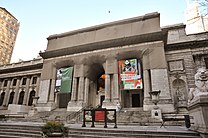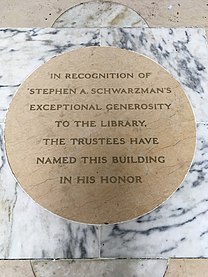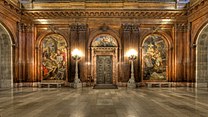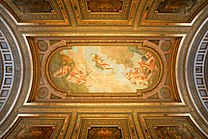New York Public Library Main Branch
| Main Branch | |
 Main entrance on 5th Avenue | |
| Country | United States |
|---|---|
| Type | Research library |
| Established | May 23, 1911 (opened to public) |
| Architect | Carrère and Hastings |
| Location | 476 Fifth Avenue, Manhattan, New York 10018 |
| Branch of | New York Public Library |
| Collection | |
| Items collected | Approximately 2.5 million (2015)[a] |
| Website | www |
New York Public Library | |
U.S. National Register of Historic Places | |
NYC Landmark No. 0246, 0880, 2592
| |
 | |
 | |
| Coordinates | 40°45′11″N 73°58′55″W / 40.75306°N 73.98194°WCoordinates: 40°45′11″N 73°58′55″W / 40.75306°N 73.98194°W |
| Built | 1897–1911 |
| Architectural style | Beaux-Arts |
| NRHP reference No. | 66000546 |
| NYCL No. | 0246, 0880, 2592 |
| Significant dates | |
| Added to NRHP | October 15, 1966[4] |
| Designated NHL | December 21, 1965[5] |
| Designated NYCL | January 11, 1967 (entire building)[1] November 12, 1974 (interior; Astor Hall, Stairs, and McGraw Rotunda)[2] August 8, 2017 (interior; Rose Main Reading Room and Public Catalog Room)[3] |
The Stephen A. Schwarzman Building, commonly known as the Main Branch or the New York Public Library,[b] is the flagship building in the New York Public Library system and a landmark in Midtown Manhattan, New York City. The branch, one of four research libraries in the library system, contains nine separate divisions. The structure contains four stories open to the public. The main entrance steps are at Fifth Avenue at its intersection with East 41st Street. As of 2015, the branch contains an estimated 2.5 million volumes in its stacks.[a] The building was declared a National Historic Landmark, a National Register of Historic Places site, and a New York City designated landmark in the 1960s.
The Main Branch was built after the New York Public Library was formed as a combination of two libraries in the late 1890s. The site, along Fifth Avenue between 40th and 42nd Streets, is located directly east of Bryant Park, on the site of the Croton Reservoir. The architectural firm Carrère and Hastings constructed the structure in the Beaux-Arts style, and the structure opened on May 23, 1911. The marble facade of the building contains ornate detailing, and the Fifth Avenue entrance is flanked by a pair of stone lions that serve as the library's icon. The interior of the building contains the Main Reading Room, a space measuring 78 by 297 feet (24 by 91 m) with a 52-foot-high (16 m) ceiling; a Public Catalog Room; and various reading rooms, offices, and art exhibitions.
The Main Branch became popular after its opening, and saw 4 million annual visitors by the 1920s. It formerly contained a circulating library, though the circulating division of the Main Branch moved to the nearby Mid-Manhattan Library in 1970. Additional space for the library's stacks was constructed under adjacent Bryant Park in 1991, and the branch's Main Reading Room was restored in 1998. A major restoration from 2007 to 2011 was underwritten by a $100 million gift from philanthropist Stephen A. Schwarzman, for whom the branch was subsequently renamed. Since 2018, the branch has been undergoing an additional expansion that is expected to be completed in 2021.
The Main Branch has been featured in many television shows, including Seinfeld and Sex and the City, as well as films such as The Wiz in 1978, Ghostbusters in 1984, and The Day After Tomorrow in 2004.
History[]
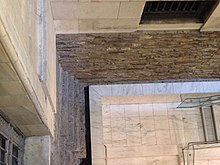
The consolidation of the Astor and Lenox Libraries into the New York Public Library in 1895,[9] along with a large bequest from Samuel J. Tilden and a donation of $5.2 million from Andrew Carnegie,[10] allowed for the creation of an enormous library system.[11] The libraries had a combined 350,000 items after the merger, which was relatively small compared to other library systems at the time.[12][13] As a point of civic pride, the New York Public Library's founders wanted an imposing main branch.[9][14] Several sites were considered, including those of the Astor and Lenox Libraries,[15] but the trustees of the libraries ultimately chose a new site along Fifth Avenue between 40th and 42nd Streets, because it was centrally located between the Astor and Lenox Libraries.[12][16] At the time, it was occupied by the obsolete Croton Reservoir;[12][17] traces of the old reservoir still exist on the library floor.[18] Dr. John Shaw Billings, who was named the first director of the New York Public Library, had created an early sketch for a massive reading room on top of seven floors of book-stacks, combined with the fastest system for getting books into the hands of those who requested to read them.[19] His design for the new library formed the basis of the Main Branch.[19][20] Once the Main Branch was opened, the Astor and Lenox Libraries were planned to close, and their functions were planned to be merged into that of the Main Branch.[12]
Construction[]
In May 1897, the New York State Legislature passed a bill allowing the site of the Croton Reservoir to be used for a public library building.[12][21] A competition among the city's most famous architects was subsequently held, and 88 designs were submitted.[22] Of these, 12 were selected for a semi-finalist round, and three went on to a finalist round.[23] Ultimately, in late 1897, the relatively unknown firm of Carrère and Hastings was selected to design and construct the new library.[19][24][25][26] The firm created a model for the future library building, which was exhibited at New York City Hall in 1900.[27] Whether John Mervin Carrère or contributed more to the design is in dispute, but both architects are honored with busts located at the bottoms of each of Astor Hall's two staircases.[19] In a later interview with The New York Times, Carrère stated that the library would contain "twenty-five or thirty different rooms", each with their own specialty; "eighty-three miles of books" in its stacks; and a general reading room that could fit a thousand guests.[28]
In any case, construction itself was delayed by the objections of Mayor Robert Anderson Van Wyck, over concerns that the city's finances were unstable.[21] A bond measure of $500,000 was allocated by the New York City Board of Estimate in May 1899. The next month, work started on the Croton Reservoir's excavation, and workers began digging through the reservoir's 25-foot-thick (7.6 m) wall.[12] Work on the foundation commenced in May 1900,[11][29] and by 1901, much of the Croton Reservoir had been excavated.[12][30] In November 1900, work was hindered by a water main break that partly flooded the old reservoir.[31] A contract to construct the building was awarded to the ;[29] this was initially controversial because the firm was not the lowest bidder.[32] After a private ceremony to mark the start of construction was held in August 1902,[29] a ceremonial cornerstone was laid on November 10, 1902.[26][30][33] The cornerstone contained a box of artifacts from the library and the city.[34] The construction of the Main Branch, along with that of the nearby Grand Central Terminal, helped to revitalize Bryant Park.[29]


Work progressed gradually on the library; the basement was completed by 1903, and the first floor by 1904.[29] However, exterior work was delayed, and when the Norcross Brothers' contract expired in August 1904, the exterior was only halfway completed.[35] During the summer of 1905, giant columns were put into place and work on the roof was begun; the roof was finished by December 1906.[11] The final remaining contracts, totaling $1.2 million, concerned the installation of furnishings in the interior.[36] The contract for interior work was awarded to the in April 1907, and the building's exterior was mostly done by the end of that year.[29] The pace of construction was generally sluggish; in 1906, an official for the New York Public Library stated that some of the exterior and most of the interior was not finished.[37]
Contractors started painting the main reading room and catalog room in 1908, and began installing furniture the following year.[29] Starting in 1910, around 75 miles (121 km) worth of shelves were installed to hold the collections that were designated for being housed there, with substantial room left for future acquisitions.[20] It took one year to transfer and install the books from the Astor and Lenox Libraries.[38] Late in the construction process, a proposal to install a municipal light plant in the basement of the Main Branch was rejected.[39] By late 1910, the library was nearly completed,[40] and officials forecast an opening date of May 1911.[41] Carrère died before the building was opened, and in March 1911, two thousand people viewed his coffin in the library's rotunda.[42]
Opening[]
On May 23, 1911, the main branch of the New York Public Library was ceremonially opened in front of 15,000 guests. The ceremony was presided over by President William Howard Taft and was attended by Governor John Alden Dix and Mayor William Jay Gaynor.[20][43][44] The following day, May 24, the public was invited, and tens of thousands went to the Library's "jewel in the crown."[20] The first item called for was Philosophy of the Plays of Shakespeare Unfolded by Delia Bacon, although the book was not actually in the Main Branch's collection at the time; this later turned out to be a publicity stunt.[34][45] The first item actually delivered was N. I. Grot's Nravstvennye idealy nashego vremeni ("Ethical Ideas of Our Time"), a study of Friedrich Nietzsche and Leo Tolstoy. The reader filed his slip at 9:08 a.m. and received his book seven minutes later.[34][46]
The Beaux-Arts Main Branch was the largest marble structure up to that time in the United States,[20] with 3.5 million volumes spread across 375,000 square feet (34,800 m2).[44] The projected final cost was $10 million, excluding the cost of the books and the land, representing a fourfold increase over the initial cost estimate of $2.5 million.[44][47] The structure ultimately cost $9 million to build,[17][43] over three times as much as originally projected.[46][48] Because there were so many visitors during the first week of the Main Branch's opening, the New York Public Library's directors initially did not count the number of visitors, but guessed that 250,000 patrons were accommodated during the first week.[49]
20th-century growth[]
The Main Branch came to be regarded as an architectural landmark. As early as 1911, Harper's Monthly magazine praised the architecture of "this interesting and important building".[26] In 1971, New York Times architectural critic Ada Louise Huxtable wrote, "As urban planning, the library still suits the city remarkably well" and praised its "gentle monumentality and knowing humanism".[50]
The Main Branch also took on importance as a major research center.[34][51] Norbert Pearlroth, who served as a researcher for the Ripley's Believe It or Not! book series, perused an estimated 7,000 books annually from 1923 to 1975.[51] Other patrons included First Lady of the United States Jacqueline Kennedy Onassis; writers Alfred Kazin, Norman Mailer, Frank McCourt, John Updike, Cecil Beaton, Isaac Bashevis Singer, and E. L. Doctorow; actors Helen Hayes, Marlene Dietrich, Lillian Gish, Diana Rigg, and Princess Grace Kelly of Monaco; playwright Somerset Maugham; film producer Francis Ford Coppola; journalists Eliezer Ben-Yehuda and Tom Wolfe; and boxer Joe Frazier.[34] The Main Branch was also used for major works and invention. Edwin Land conducted research at the building for his later invention, the Land Camera, while Chester Carlson invented Xerox photocopiers after researching photoconductivity and electrostatics at the library.[34][51] During World War II, American soldiers decoded a Japanese cipher based on a Mexican phone book whose last remaining copy among Allied nations existed at the Main Branch.[51]
1920s and 1930s[]
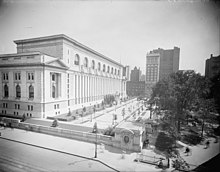
Initially, the Main Branch was opened at 1 p.m. on Sundays and 9 a.m. on all other days, and it closed at 10 p.m. each day. This was to encourage patrons to use the new library.[46][52] By 1926, the library was heavily patronized, with up to 1,000 people per hour requesting books. The library was most used between 10 a.m. to 12 p.m. and 3:30 to 5:50 p.m., and from October through May. The most highly requested books were those for economics and American and English literature, though during World War I geography books were the most demanded because of the ongoing war.[53] It was estimated that 4 million people per year used the Main Branch in 1928, up from 2 million in 1918[54] and 3 million in 1926.[55] There were 1.3 million books requested by nearly 600,000 people through call slips in 1927.[56] By 1934, though annual patronage held steady at 4 million visitors, the Main Branch had 3.61 million volumes in its collection.[57]
Due to the increased demand for books, new shelves were installed in the stockrooms and the cellars by the 1920s to accommodate the expanded stacks. However, this still proved to be insufficient.[56] The New York Public Library announced an expansion of the Main Branch in 1928.[54] Thomas Hastings prepared plans for new wings near the north and south sides of the structure, which would extend eastward toward Fifth Avenue, as well as a storage annex in Bryant Park to the west.[56] The expansion was planned to cost $2 million, but was never built.[58] After Hastings died in 1929, it was revealed that his will contained $100,000 for modifications to the facade, with which he had been dissatisfied.[59]
A theater collection was installed in the Main Reading Room in 1933.[60] Two years later, the Bryant Park Open-Air Reading Room was established, operating during the summer. The reading room was meant to improve the morale of readers during the Great Depression, and it operated until 1943, when it closed down due to a shortage of librarians.[61] In 1936, library trustee George F. Baker gave the Main Branch forty issues of the New-York Gazette from the 18th century, which had not been preserved anywhere else.[62] In 1937, the doctors Albert and Henry Berg made an offer to the library's trustees to donate their collections of rare English and American literature. After Henry died, the collection was dedicated in his memory.[63] The Berg Reading Room was formally dedicated in October 1940.[64]
During the 1930s, Works Progress Administration (WPA) workers helped maintain the Main Branch. Their tasks included upgrading the heating, ventilation, and lighting systems; refitting the treads on the branch's marble staircases; painting the bookshelves, walls, ceilings, and masonry; and general upkeep.[65][66] The WPA allocated $2.5 million for the building's maintenance.[67] In January 1936, it was announced that the Main Branch's roof would be renovated as part of a seven-month WPA project.[68]
1940s and 1950s[]
During World War II, the fifteen large windows in the Main Reading Room were blacked out, though they were later uncovered.[69] In the following years, the Main Reading Room became neglected: broken lighting fixtures were not replaced, and the room's windows were never cleaned.[69][70] Unlike during World War I, war-related books at the Main Branch did not become popular during World War II.[71] A room for members of the United States Armed Forces was opened in 1943.[72]
In 1944, the New York Public Library proposed another expansion plan. The stacks' capacity would be increased to 3 million books, and the circulating library in the Main Branch would be moved to a new 53rd Street Library.[73] The circulating library at the Main Branch was ultimately kept for the time being, though the circulating library's single room soon became insufficient to host all of the circulating volumes.[74] Subsequently, in 1949, the library asked the city to take over responsibility for the Main Branch's circulating and children's libraries.[75] As part of the modernization of the Main Branch, newly delivered books started being processed in that building, rather than at various circulation branch libraries.[76]
1960s through 1990s[]

Minor repairs at the Main Branch occurred during the 1960s. The city government allocated money for the installation of fire sprinklers in the main branch's stacks in 1960.[77] In 1964 contracts were awarded for the installation of a new floor level above the south corridor on the first floor, as well as for replacement of the skylights.[78] By the mid-1960s, the branch contained 7 million volumes[79] and had outgrown its 88 miles (142 km) of stacks.[80]
The circulating facilities at the Main Branch continued to grow, and in 1961, the New York Public Library convened a group of six librarians to look for a new facility for the circulating department.[74] The library bought the Arnold Constable & Company department store at 8 East 40th Street, at the southeast corner of Fifth Avenue and 40th Street across from the Main Branch.[81] The Main Branch's circulating collection was moved to the Mid-Manhattan Library in 1970.[74]
During the 1970s, the New York Public Library as a whole experienced financial troubles,[82] which were exacerbated by the 1975 New York City fiscal crisis.[51] As a cost-cutting measure, in 1970, the library decided to close the Main Branch during Sundays and holidays.[83] The library also closed the Main Branch's science and technology division in late 1971 to save money, but private funds allowed the division to reopen in January 1972.[84] The lions in front of the Main Branch's main entrance were restored in 1975.[85]
The Catalog Room was restored starting in 1983.[86][87] Ten million catalog cards, many of which were tattered, were replaced with photocopies that had been created over six years at a cost of $3.3 million.[87][88] The room was subsequently renamed for Bill Blass, the fashion designer, who gave $10 million to the New York Public Library in 1994.[86][89] Other divisions were added to the Main Branch during the 1980s. These included the Pforzheimer Collection of Shelley and His Circle in 1986,[90] and the Wallach Division of Art, Prints and Photographs in 1987.[91]
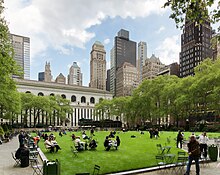
In the late 1980s, the New York Public Library decided to expand the Main Branch's stacks to the west, underneath Bryant Park.[34][80] The project was originally estimated to cost $21.6 million and would be the largest expansion project in the Main Branch's history.[92] It was approved by the city's Art Commission in January 1987,[93] and construction on the stacks started in July 1988.[34] The expansion required that Bryant Park be closed to the public and then excavated, but because the park had grown dilapidated over the years, the stack-expansion project was seen as an opportunity to rebuild the park.[92] The library added more than 120,000 square feet (11,000 m2) of storage space and 84 miles (135 km) of bookshelves under Bryant Park, doubling the length of the stacks in the Main Branch.[80] The new stacks were connected to the Main Branch via a 120-foot (37 m) tunnel.[34] Once the underground facilities were completed, Bryant Park was completely rebuilt,[94] with 2.5 or 6 feet (0.76 or 1.83 m) of earth between the park surface and the storage facility's ceiling.[34][95] The extension was opened in September 1991 at a cost of $24 million;[34] however, it only included one of two planned levels of stacks.[96] Bryant Park was reopened in mid-1992 after a three-year renovation.[95]
The Main Reading Room was closed in July 1997 for renovations.[97] It was restored over a sixteen-month period and reopened in November 1998.[98][99] The restoration entailed the cleaning and repainting of the ceiling, cleaning the windows, refinishing of the wood, and removal of partitions within the room,[70][86][100] as well as replacing sixty desk lamps and installing energy-efficient window panes.[101] It was renamed the Rose Main Reading Room, after the children of a benefactor who had given $15 million toward the renovation.[69] Also in 1998, the New York State government allocated funding for the Main Branch to install technology services such as computers.[102] The bungalow in the Library's South Court was taken apart the same year.[34][103]
21st-century changes[]
2000s: start of renovations[]
A four-story glass structure was erected on the site of the South Court, an enclosed courtyard on the Main Branch's south side, starting in the late 1990s. The structure cost $22.2 million and included a floor area of 42,220 square feet (3,922 m2).[104] Opened in 2002, the South Court structure was the first permanent above-ground addition to the Main Branch since its opening.[34] The pop-up reading room in Bryant Park was re-established in summer 2003. The "room" contained 700 books and 300 periodicals.[61]
By 2004, streaks were already blackening the white marble and pollution and moisture were corroding the ornamental statuary. According to The New York Times, "tiny particles of rubber scattered by passing car tires have accumulated on the building, mixing gradually with water to turn the marble into gypsum, which causes the outer layer to crumble in a sugaring effect." In December 2005, the Lionel Pincus and Princess Firyal Map Division space, with richly carved wood, marble, and metalwork, was restored.[105]
In 2007, the library announced that it would undertake a three-year, $50 million renovation of the building exterior, which had suffered damage from weathering and automobile exhaust. The marble structure and its sculptural elements were to be cleaned; three thousand cracks were to be repaired; and various components would be restored. All of the work was scheduled to be completed by the centennial in 2011.[106] Library director Paul LeClerc said in 2007 that "my ambition is for this to be the building you simply must see in New York at nighttime because it is so beautiful and it is so important." By late 2007, library officials had not yet decided whether to try to restore damaged sculptural elements or just clean and "stabilize" them. Cleaning would be done either with lasers or by applying poultices and peeling them off.[105]
Stephen A. Schwarzman donated $100 million toward the renovation and expansion of the building, and in April 2008, the library announced that the main branch building would be renamed in his honor. As a condition of the gift, Schwarzman's name would be displayed at each public entrance.[107][108] Later that year, British architect Norman Foster was chosen to design the Main Branch's renovation. To pay for the renovations, the New York Public Library was attempting to sell the Mid-Manhattan and Donnell branches, the latter of which had already found a buyer.[109] Nicolai Ouroussoff, former architecture critic for The New York Times, opined that Foster's selection was "one of a string of shrewd decisions by the library that should put our minds at ease".[110]
2010s: the Central Library Plan and after[]
By 2010, while renovations on the Main Branch were ongoing, the New York Public Library had cut back its staff and budget in other branches following the Great Recession of 2008.[111][112] In 2012, a Central Library Plan was announced, in which the nearby Mid-Manhattan Library and Science, Industry and Business Library would be closed, and that the Main Branch would be turned into a circulating library.[113][114] As part of the plan, over a million books would have been put into storage in the (ReCAP) warehouse in New Jersey, shared with Princeton University and Columbia University.[112] Although some critics praised the plan as a move that would allow visitors to make greater use of the Main Branch's research facilities,[115][116] a majority spoke out against it,[117][118][119] with one editorial deriding it as "cultural vandalism".[120] Academics, writers, architects and civic leaders signed a letter of protest against the plan,[121] and Princeton history professor Anthony Grafton wrote that "readers who want to consult a book will often have to order it in advance—and may find, as readers sometimes do here, that real delivery times are slower than advertised ones."[122] After a protracted six-year battle, and two public interest lawsuits, the Central Library Plan was abandoned in May 2014 due to pressure by its opponents and the election of Bill de Blasio as mayor.[123][124] Subsequently, an $8 million gift from Abby and Howard Milstein helped fund the renovation of the second level of stacks beneath Bryant Park, so that they could be used to store the books.[96] The controversy was damaging to the reputation of not only the library's board, but of its president, Anthony Marx. In a book about the drawn out, often secretive initiatives to sell real estate and remove the heart of a treasured landmark, Scott Sherman concluded that Marx and his wealthy supporters "lacked prudence: they applied radical, free market solutions to complex institutional problems. In the end, elected officials in New York City had to save the NYPL from its own trustees."[125]
In May 2014, one of the "gilded-plaster rosettes" in the ceiling of the Rose Main Reading Room fell to the floor.[126] The NYPL closed the Rose Main Reading Room and the Public Catalog Room for renovations. The $12 million restoration project included restoring the rosettes and supporting them with steel cables, as well as installing LED lamp fixtures.[127] The NYPL commissioned EverGreene Architectural Arts to recreate the mural in the Bill Blass Public Catalog Room, which had "suffered irreparable discoloration, overpainting and water damage" during its 105-year history.[128] The NYPL also replaced its historic chain-and-lift book conveyor system with a new delivery system using "book trains".[96] The restored Rose Main Reading Room and Bill Blass Public Catalog Room reopened on October 5, 2016.[129][130]
In August 2017, the Main Branch temporarily started hosting an interim circulating library at 42nd Street.[131] The interim library was to hold part of the collection of the Mid-Manhattan Library while the Mid-Manhattan building was closed for renovations, which were scheduled to be completed in 2020.[132] The Mid-Manhattan Branch's collection of pictures was also temporarily relocated to the Main Branch.[133]
In November 2017, the New York Public Library board approved a $317 million master plan for the Main Branch, which would be the largest renovation in the branch's history. The plan, designed by architecture firms Mecanoo and Beyer Blinder Belle, would increase publicly available space by 20 percent, add a new entrance at 40th Street, create the Center for Research and Learning for high-school and college students, add elevator banks, and expand space for exhibitions and researchers.[134][135] At the time of approval, $308 million of funds had been raised, and construction was expected to be completed in 2021.[136] The renovations began in July 2018 with the start of construction on the Lenox and Astor Room, a scholar's center, on the second floor.[137][138] The Landmarks Preservation Commission approved the 40th Street entrance with minor modifications in March 2019.[108] That August, the NYPL announced that the lions outside the Main Branch's front entrance would be restored in September and October at a cost of $250,000.[139][140]
Divisions[]

There are nine divisions at the New York Public Library's Main Branch, of which eight are special collections.[141]
General Research Division[]
The General Research Division is the main division of the Main Branch and the only one that is not a special collection. The division is based out of the Rose Main Reading Room and the Bill Blass Public Catalog Room. The division contains 43 million items in more than 430 languages.[142]
Milstein Division of U.S. History, Local History and Genealogy[]
The Irma and Paul Milstein Division of U.S. History, Local History and Genealogy houses one of the largest publicly available genealogical collections in North America. Though the division contains many New York City-related documents, it also contains documents collected from towns, cities, counties, and states across the U.S., as well as genealogies from around the world.[143] The division acquired the holdings of the New York Genealogical and Biographical Society in 2008.[144][145]
Map Division[]
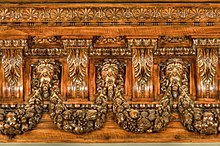
The Lionel Pincus and Princess Firyal Map Division was created in 1898. It contains more than 20,000 atlases and 433,000 sheet maps, dating to as early as the 16th century. The collection includes maps on local, regional, national, and global scales as well as city maps, topographic maps, and maps in antiquarian and digitized formats.[146]
Manuscripts and Archives Division[]
The Manuscripts and Archives Division comprises over 5,500 collections. These include, 700 cuneiform tablets, 160 illuminated manuscripts from the Middle Ages and Renaissance periods, notable people's and entities' papers, publishing archives, social and economics collections, and papers about the New York Public Library's history.[147] The division supplements similar divisions at the Schomburg Center for Research in Black Culture in Harlem, and the New York Public Library for the Performing Arts at Lincoln Center.[147]
Dorot Jewish Division[]
The Dorot Jewish Division contains documents about Jewish subjects and the Hebrew language. The division, founded in 1897, contains documents and books from the Astor and Lenox Libraries; the Aguilar Free Library; and the private collections of Leon Mandelstamm, Meyer Lehren, and Isaac Meyer. The division is named for the , who made a formal endowment for the Chief of Division in 1986.[148]
Berg Collection of English and American Literature[]
The Henry W. and Albert A. Berg Collection of English and American Literature contains rare books, first editions, and manuscripts in English and American literature. The collection includes over 35,000 works from 400 individual authors.[63] The collection was created in 1940 with a donation from Albert Berg in memory of his brother Henry,[64] and was formally endowed in 1941.[63] The initial collection comprised 3,500 books and pamphlets created by over 100 authors.[149][63] An additional 15,000 works came from Owen D. Young, who donated his private collection to the library in 1941.[63][150]
Pforzheimer Collection of Shelley and His Circle[]
The Carl H. Pforzheimer Collection of Shelley and His Circle is a collection of around 25,000 works from the English Romanticism genre, created in the 18th and 19th centuries. It was donated by the estate of oil financier Carl Pforzheimer in 1986. According to the New York Public Library's website, the collection contains works from English Romantic poet Percy Bysshe Shelley; Shelley's second wife Mary Wollstonecraft Shelley and her family members, including William Godwin, Mary Wollstonecraft, and Claire Clairmont; and other contemporaries including "Lord Byron, Teresa Guiccioli, Thomas Jefferson Hogg, Leigh Hunt, Thomas Love Peacock, Horace Smith, and Edward John Trelawny".[90]
Rare Book Division[]
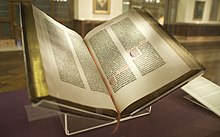
The Rare Book Division requires pre-registration for researchers before they are allowed to enter. The collection includes 800 incunable works published in Europe before 1501, Americana published before 1801, and American newspapers published before 1865, as well as over 20,000 broadsides, old atlases, and works about voyages. The division also contains rare Bibles, including the first Gutenberg Bible to be brought to the U.S., the first Native American language Bible, and the first Bible created in the U.S. In addition, it includes first editions and copies from notable writers, including William Shakespeare, copies of The Pilgrim's Progress printed before 1700, Voltaire's entire work, and Walt Whitman's personal copies of his own work. The division houses rare artifacts as well, such as the first book printed in North America and the first English-language book printed in the U.S.[152]
Wallach Division of Art, Prints and Photographs[]
The Miriam and Ira D. Wallach Division of Art, Prints and Photographs was created by a gift of the Wallach family in 1987. The collection includes over one million works of art as well as 700,000 monographs and periodicals.[91]
Exterior[]
The New York Public Library's Main Branch measures 390 feet (120 m) on its north–south axis by 270 feet (82 m) on its west–east axis.[26][46][105] The library is located on the east side of the block bounded by Fifth Avenue on the east, 40th Street on the south, Sixth Avenue on the west, and 42nd Street on the east.[153] A balcony wraps around the building.[119] The north end of the building sits above entrances to the Fifth Avenue station of the New York City Subway, serving the 7 and <7> trains.[154] The station was built as part of the Interborough Rapid Transit Company's Flushing Line,[155] and was opened in 1926 with a ceremony at the Main Branch.[156]
The marble on the library building is about three feet thick, and the structure is composed entirely of Vermont marble and brick.[105] During construction, the builders conducted quality checks on the marble, and 65% of the marble quarried for the Main Branch was rejected and used in other buildings such as Harvard Medical School.[34] The exterior is composed of 20,000 blocks of stone, each of which is numbered.[105] An elaborate cornice with sculpted figures wraps around the top of the structure's exterior.[17]
Fifth Avenue side[]
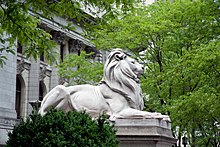
The Main Branch faces Fifth Avenue on its east side.[17] A balcony wraps along the Fifth Avenue elevation. The Fifth Avenue entrance is reached by a grand marble stairway extending west from the avenue's intersection with 41st Street. It ascends to a pavilion underneath a portico with six Corinthian columns and three archways.[17][24] These lead to the first floor of the structure, which is actually one story above ground level.[157] On either side of the Fifth Avenue entrance pavilion, there are alcoves with sculptures of figures inside them, as well as five arched windows on the first floor.[17]
The alcoves on the Fifth Avenue facade contained figures sculpted by Frederic MacMonnies called "Beauty" and "Truth".[26] These figures sit above small fountains inside the alcoves.[158] They were shut off from 1942 and 1957,[159] and again from the 1980s to 2015.[158] George Grey Barnard also designed pediments for sculptures to be installed above the main entrance, representing "Life" and "Painting and Sculpture".[160] When the sculptures were erected in 1915, he unsuccessfully sued the installers for $50,000 because they did not fit with his vision.[161]
Two stone lions, made of Tennessee marble and sculpted by the Piccirilli Brothers based on a design by Edward Clark Potter, flank the stairway.[24][162] According to one legend, the lions flank the steps so patrons could read "between the lions".[163] They are a trademark of the New York Public Library, which uses a single stone lion as its logo.[162] Their original names, "Leo Astor" and "Leo Lenox" (in honor of the library's founders) were transformed into Lord Astor and Lady Lenox (although both lions are male), and in the 1930s they were nicknamed "Patience" and "Fortitude" by Mayor Fiorello La Guardia, who chose the names because he felt that the citizens of New York would need to possess these qualities to see themselves through the Great Depression. Patience is on the south side, to the left of the entrance stairway, and Fortitude on the north, to the right.[20][162] (One local wag suggests a mnemonic for remembering which is which: Fortitude is the one closer to Fortitu Street.)[164] By 1975, the lions' Tennessee marble had degraded because of pollution,[163] so they were restored over a three-week period.[85] They were restored again during the 2007–2011 renovation,[162] and were set to be restored once again in late 2019.[139][140]
Northern and southern sides[]
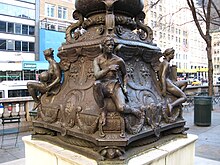
The northern and southern facades of the building are located along 42nd and 40th Streets, respectively. The northern side contains an entrance to the ground level and the temporary Mid-Manhattan branch, while the southern side does not contain a public entrance.[157] These entrances are flanked by flagpoles whose sculpted bronze bases were designed in 1912 by Thomas Hastings. They were realized by the sculptor Raffaele Menconi, who often worked closely with New York architects of the Beaux-Arts generation and had a deft command of the 16th-century Italian Mannerist classical idiom that was required by Hastings's design. The bronzes were cast at Tiffany Studios in Long Island City.[165] They were rededicated to New York's former Reform mayor, John Purroy Mitchell, in 1941.[166]
The building contained an enclosed courtyard on its south side called the South Court, measuring 88 by 88 square feet (8.2 by 8.2 m2). It was originally a drop-off location for horse carriages.[104] The court contained a marble fountain and horse trough, with a bungalow erected in 1919 as an employees' break area. The fountain was destroyed in 1950 and replaced with a parking lot, and the bungalow was taken apart in 1998.[34][103] A four-story glass structure was erected on the site of the South Court, and it opened in 2002.[34][104]
Bryant Park side[]
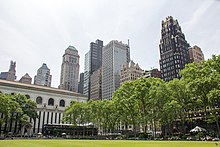
The west side, which faces Bryant Park, contains "tall, narrow windows" that provide views into the stacks inside the Main Branch.[17] The narrow windows allow light to enter the stacks below the third-floor Rose Main Reading Room. Above the tall windows, near the top of the facade, are nine large arched windows that illuminate the reading room itself.[46]
Interior[]
The interior of the Main Branch consists of four publicly accessible floors: the ground level and the first through third floors.[157] On each floor, there is a corridor on the eastern side of the main building, which runs the length of the building from north to south.[24] Originally, the interior collectively contained more than 200 rooms, and the building had a footprint of 115,000 square feet (10,700 m2).[26] Generally, lower room numbers are located on the south side of the building, and higher room numbers on the north side.[157][167] There is a pair of public stairways on the north side of the building, which lead between the ground and third floors; the stairs share landings in the middle of each flight.[157] The interior contains ornate detail from Carrère and Hastings, which extended to such minute details as doorknobs and wastebaskets.[34]
The western side of the building, from the cellar to the second floor, contains part of the Main Branch's storage stacks. Supplementing the Main Reading Room on the third floor, there are 21 other reading rooms in the Main Branch, including a ground-floor room with a cast-iron ceiling.[24] There were originally 1,760 seats in all of the reading rooms combined, of which 768 were located in the Main Reading Room.[168]
Cellar and ground floor[]
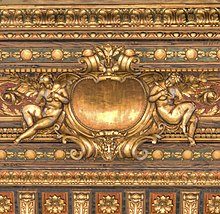
The cellar, which is not open to the public, is located below the ground floor. It was initially used for a mechanical plant,[24] and contains remnants of the original Croton Reservoir.[18][24]
The ground floor contains the entrance to 42nd Street as well as the temporary branch of the Mid-Manhattan Library.[157] Originally it contained a coat-check, circulating library, newspaper room, and children's-book room. There were also spaces for telephones, a "library-school office", and a "travelling-library office".[52] Room 80, originally the circulating library, is now part of Bartos Forum. The former newspaper room in room 78 is now the children's-book room, and the former children's-book room in room 81 is now the temporary branch of the Mid-Manhattan Library.[52][157]
First and second floors[]
Above the ground floor is the first floor. The staircase entrance from Fifth Avenue opens up into the first-floor lobby, known as Astor Hall.[46][169] This floor contains the Picture Collection (room 100), Periodical Room (room 108), and Jewish Division (room 111, former Periodicals Room) on the south side. On the north side are the Milstein Division (room 121, former Patents Room), Milstein Microforms (room 119), and Map Division (room 117). The Wachenheim Gallery, the library shop, the Bartos Education Center, and the Gottesman Hall (room 111, former Exhibition Room) are located in rooms that open into Astor Hall.[157][169] The first floor also used to contain various supervisors' offices, a library for the blind, and a technology room.[169]
The second floor contains the Jill Kupin Rose Gallery,[157] which contains ongoing exhibitions.[170] This floor contains several small rooms extending to the north, west, and south.[157] One of these is the Wachenheim Trustees' Room, which contains wood paneling, parquet floors, and a fireplace made of white marble.[24] Originally, this level contained director's and assistant director's offices; the Slavonic, Jewish, and Oriental Collections; and rooms for science, economics and sociology, and public documents.[171] The former science room at room 225 is now the Cullman Center, while room 228, the former economics and sociology room, has been split into two rooms.[157][171]
Astor Hall[]
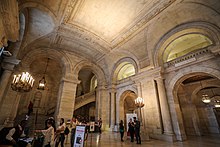
Astor Hall is the first-floor lobby,[46][157][169][172] reached from the portico at the top of the stairs to Fifth Avenue.[17][24][172] The hall measures 70 by 44 feet (21 by 13 m) in floor area, and its ceiling is 34 feet (10 m) above the floor. The entirety of the space is made of stone, and the ceiling of the hall is a low barrel vault with arch openings on the sides.[172] The names of major donors are inscribed on the pillars in Astor Hall.[119]
Two grand marble staircases on the north and south sides of Astor Hall ascend to the second floor.[46][172] There are bronze busts of Carrère and Hastings, created in 1940 and 1935 respectively, at the bottom of the stairways that lead from Astor Hall. Facing westward from the entrance, the Carrère bust is located near the stair on the south side, while the Hastings bust is located near the stair on the north side.[19][172] The staircases ascend several steps, perpendicular to and away from the hall, before turning 90 degrees westward and ascending parallel to each other for the rest of the flight to the second floor.[172] At the top of the flight, another identical pair of staircases, which are perpendicular to the staircases leading from the Astor Hall, leads from the second floor to the McGraw Rotunda on the third floor.[173]
Third floor[]
The third floor contains the McGraw Rotunda on the east side of the building.[157] A passageway called the Print Gallery extends to the building's southern side, and one publicly accessible room, the Wallach Division, is adjacent to the gallery. Similarly, the Stokes Gallery extends northward, with the Berg and Pforzheimer Collections branching off of it.[157] The Salomon Room branches off the McGraw Rotunda to the east. To the west is the Bill Blass Public Catalog Room, which leads into the large Rose Main Reading Room.[157]
McGraw Rotunda[]
The McGraw Rotunda (formerly Central Hall) is a rectangular-shaped space on the third floor. It is situated between the Public Catalog and Salomon Rooms, which are respectively located to the west and east, and separates two passageways that lead northward and southward.[157][173] The rotunda contains a red marble base with dark wood walls and a plaster barrel vault. There are alcoves on the side walls, supported by columns with Corinthian capitals, which are intended for murals.[173]
The rotunda contains a set of panels painted by Edward Laning in the early 1940s as part of a WPA project. The work includes four large panels, two lunettes above doorways to the Public Catalog and Salomon Rooms, and a ceiling mural painted on the barrel vault. The four panels are located on the east and west walls and depict the development of the written word. The lunette above the Public Catalog Room's doorway is "Learning to Read", and the lunette about the Salomon Room's doorway is "The Student".[173][174] The ceiling mural is called "Prometheus Bringing Fire to Men".[173] The four panels and two lunettes were completed in 1940,[174] and the ceiling mural was completed in 1942.[173]
Rose Main Reading Room[]
The Main Branch's Deborah, Jonathan F. P., Samuel Priest, and Adam R. Rose Main Reading Room, officially Room 315 and commonly known as the Rose Main Reading Room, is located on the third floor of the Main Branch.[157] The room is 78 by 297 feet (24 by 91 m) with a 52-foot-high ceiling, nearly as large as the Main Concourse at Grand Central Terminal.[46] It was originally described as being in the Renaissance architectural style,[40][175] but was later considered to be of a Beaux-Arts design.[86] The Main Reading Room was renovated and renamed for the Rose family in 1998–1999;[86][98][99] and further renovations to its ceiling were completed in 2016.[99][130] The room became a New York City designated landmark in 2017.[176]
The room is separated into two sections of equal size by a book-delivery desk.[177] The desk is made of oak and is covered by a canopy,[178] with arches held up by Tuscan columns.[177] The north hall leads to the Manuscripts and Archives Reading Room, while the south hall leads to the Art and Architecture Reading Room; picture taking is only allowed in a small section of the south hall.[46] The doorways into the Main Reading Room contain large round pediments, which contrast with the smaller triangular pediments in the branch's other reading rooms.[179] There is intricate detail on the room's smaller metalwork, such as doorknobs and hinges.[175] The floors of the Main Reading Room and the connected Catalog Room are composed of red tiles, with marble pavers set in between the tiles, which indicate how the furniture should be arranged.[179] The marble pavers demarcate the boundaries of the aisles.[175]

The Main Reading Room is furnished with low wooden tables and chairs, with four evenly-spaced brass lamps on each table. There are two columns of tables in each hall, separated by a wide aisle.[175] Originally, there were 768 seats,[180] but the number of seats has been reduced over the years to 624.[175] Each spot at each table is assigned a number so that library staff can deliver books to a given seat number. The room is also equipped with desktop computers providing access to library collections and the Internet, as well as docking facilities for laptops. Readers may fill out forms requesting books brought to them from the library's closed stacks, which are delivered to the indicated seat numbers. There are special rooms named for notable authors and scholars who have used the library for research.[20] Surrounding the room are thousands of reference works on open shelves along the room's main and balcony levels, which may be read openly.[24][177] At the time of the library's opening, there were about 25,000 freely accessible reference works on the shelves.[168] There are three levels of bookshelves: two on the main floor beneath the balcony, and one on the balcony.[177]
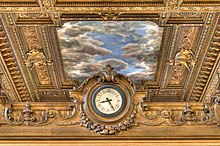
Massive windows and grand chandeliers illuminate the space.[177][181] There are eighteen grand archways, of which fifteen contain windows: nine face Bryant Park to the west, and six face east. The other three archways form a wall with the Public Catalog Room to its east, and the middle archway contains windows that face into the Catalog Room.[177] There are two rows of nine chandeliers in the Main Reading Room. These were originally fitted with incandescent light bulbs, an innovation at the time of the library's opening, and were powered by the library's own power plant.[181] The lights on the chandeliers are arranged like an inverted cone, with four descending "tiers" of light bulbs.[177]
The plaster ceiling is painted to emulate gilded wood, with moldings of classical and figurative details.[182] The Klee-Thomson Company plastered the ceiling.[183] According to Matthew Postal, the moldings include "scroll cartouches bordered by cherubs, nude female figures with wings, cherub heads, satyr masks, vases of fruit, foliate moldings, and disguised ventilation grilles."[182] The moldings frame a three-part mural, created by and completed in 1911.[103][184] Though no clear photographs exist of the mural's original appearance, the mural in its present incarnation depicts clouds and sky.[182] When the ceiling was restored in 1998, the original mural was deemed to be unsalvageable, and instead, recreations were painted by Yohannes Aynalem.[103] The ceiling was restored again from 2014 to 2016.[130]
Public Catalog Room[]
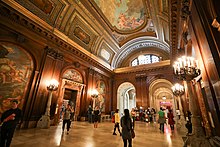
The Bill Blass Public Catalog Room, also located in Room 315, is adjacent to the Main Reading Room, connecting it with the McGraw Rotunda.[157] The Catalog Room's central location between the McGraw Rotunda and Main Reading Room makes it a de facto foyer for the latter.[179] The room measures 81 by 77 feet (25 by 23 m).[46] Similar to the Main Reading Room, it has a 52-foot-high ceiling.[15] Four chandeliers, of identical design to those in the Main Reading Room, hang from the ceiling.[177] The ceiling of the Public Catalog Room also contains a 27-by-33-foot (8.2 by 10.1 m) section of James Wall Finn's 1911 mural.[184]
Possibly the first renovation of the Catalog Room occurred in 1935,[86] when its ceiling was repainted.[66] Further modifications occurred in 1952 when metal cabinets replaced the original oak cabinets as a result of the catalog room's quick expansion, with 150,000 new catalog cards being added each year.[86][185] The Catalog Room was restored in 1983[87] and renamed for Bill Blass in 1994.[89]
There is an information desk on the north side on the room, on one's right side when entering from the rotunda. Originally, visitors would receive card slips with numbers on them and then be directed to one of the Main Reading Room's halves based on their card number.[180][179] The Public Catalog Room also contains waist-high oak desks.[175] These desks contain computers that allow New York Public Library cardholders to search the library's catalog.[186]
Salomon Room[]
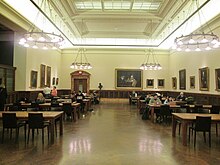
The Edna Barnes Salomon Room, located east of the McGraw Rotunda in Room 316,[157] is usually utilized as an event space.[187] The 4,500-square-foot (420 m2) was originally intended as a picture gallery, and oil paintings still hang on the walls. In 2009, it was converted to a "wireless Internet reading and study room" to provide overflow capacity for internet users who cannot fit in the Main Reading Room.[188]
Non-public stacks[]
The stacks within the Schwarzman Building are a main feature of the building. Housed beneath the Rose Main Reading Room are a series of stacks, which hold an estimated 2.5 million books.[a] At the time of the branch's opening, the stacks could hold 2.7 million books on 63.3 miles (101.9 km) of shelves.[26][168] There were another 500,000[168] or 800,000 books stored in various reading rooms.[26] The central stacks, as they are called, have a capacity of 3.5 million books[8] across 88 miles of bookshelves,[80] spanning seven stories.[96] As of 2015, the Main Branch hosts 300,000 books in various reading rooms, though there are none in the central stacks themselves, due to the deteriorated condition of the stacks.[8] There were proposals to demolish the central stacks to make room for the Mid-Manhattan Branch as part of the unrealized Central Library Plan in the early 2010s.[189] As of 2019, the library's trustees have still not determined how to use the abandoned stacks in the main building.[190][c]
Another 84 miles of stacks under Bryant Park was added in an expansion between 1987 and 1991.[34][80] The Bryant Park stacks comprise two levels of climate-controlled storage areas.[96] The stacks under Bryant Park contain 1.2 million books on what is called "Level 1",[8] which was completed in the 1991 expansion. A second level of stacks below it, "Level 2", had not been finished when the 1991 expansion was opened.[96] Another 2.5 million books were being moved from the NYPL's ReCAP warehouse in New Jersey to Level 2 as of 2015, and when that was finished, the number of books in the Main Branch's stacks would rise to four million.[8] The Level 2 stacks are called the "Milstein Stacks", after a major donor,[96] and opened in January 2017.[191] As of 2017, the stacks also contain about 400,000 circulating volumes that are usually housed in the Mid-Manhattan Branch, which was closed for renovations until 2020.[189]
Books are delivered from the Bryant Park stacks to the reading rooms on the first through third floors using the "book train". The $2.6 million book delivery system was installed in 2016, replacing a series of mechanized lifts. It contains a conveyor belt and 24 small red carts emblazoned with the library's lion logo, which each carry up to 30 pounds (14 kg) of books between the stacks and the reading rooms. Each cart moves 75 feet (23 m) per minute and use gears to climb steep or vertical grades.[96][192] The old one took ten minutes to retrieve a book,[193] but the new book-delivery system was described as being twice as fast as the old system.[96]
Library Way[]
Leading up to the Main Branch, on 41st Street between Park and Fifth Avenues, is a series of plaques known as Library Way. Library Way comprises a series of illustrated bronze sidewalk plaques featuring quotes from famous authors, poets, and other notables. It features 48 unique plaques in all, but each plaque is duplicated along the north and the south sides of 41st Street, thus totaling 96 plaques.[194] According to The Wall Street Journal, a panel composed of "the Grand Central Partnership, which manages the Grand Central Business Improvement District; and the New Yorker magazine" chose the quotes in the 1990s, while designed the plaques.[195][196] Brochures are available at the Friends of the Library counter in the Main Branch's Astor Hall, on the first floor.[197][198] Granite plaques of similar style can also be seen on the sidewalks of Broadway in Manhattan's Financial District, placed in honor of ticker tape parades held there in the past, as well as on Broadway in the Garment District, where plaques commemorate fashion designers.[199]
Landmark designations[]
The Main Branch was declared a National Historic Landmark in 1965[5][79] and listed on the National Register of Historic Places in 1966.[4] The New York City Landmarks Preservation Commission designated the exterior as a landmark in 1967.[200] The Landmarks Preservation Commission subsequently designated the Astor Hall, first-to-third-floor stairs, and McGraw Rotunda as landmarks in 1974.[201][202] The Rose Main Reading Room and Public Catalog Room were separately made New York City designated landmarks in 2017, after a protracted effort that was opposed by the library's board.[176]
In popular culture[]
Film[]
The Main Branch appears or is depicted in the following films:
- 42nd Street (1933)[119]
- The Clock (1945)[203]
- On the Town (1949)[203]
- Pickup on South Street (1953)[204]
- Breakfast at Tiffany's (1961)[204][119][205]
- Two for the Seesaw (1962)[204]
- You're a Big Boy Now (1966)[205]
- The Possession of Joel Delaney (1972)[204]
- Network (1976)[204]
- The Wiz (1978)[206][119]
- Ghostbusters (1984)[207][204][205]
- Prizzi's Honor (1984)[205]
- Regarding Henry (1991)[204][205]
- Quiz Show (1994)[205]
- Picture Perfect (1997)[204]
- The Thomas Crown Affair (1999)[203][204][205]
- Finding Forrester (2002)[205]
- Head over Heels (2001)[204]
- Maid in Manhattan (2002)[205]
- Spider-Man (2002)[206][204]
- The Time Machine (2002)[203][205]
- 13 Going on 30 (2004)[204][205]
- The Day After Tomorrow (2004)[204][205][206]
- Shortcut to Happiness (2004)[204]
- Spider-Man 3 (2007)[205]
- Sex and the City (2008)[204][205]
- Uncertainty (2008)[204]
- Arthur (2011)[204]
- The Adjustment Bureau (2011)[204]
- We'll Take Manhattan (2012)[204]
- Winter's Tale (2014)[204]
- Ex Libris: The New York Public Library (2017)[189]
Television[]
Episodes of TV series that depicted the Main Branch included "The Library", an episode of Seinfeld,[208] as well as "The Persistence of Memory", the eleventh part of Carl Sagan's TV series Cosmos.[209]
Literature[]
The Main Branch also appears in literature, including:
- Lawrence Blochman's Death Walks in Marble Halls (1942)[210]
- Jane Smiley's Duplicate Keys (1984)[211][212]
- Akimi Yoshida's Banana Fish (1985)[213]
- Allen Kurzweil's The Grand Complication (2001)[214][215]
- Cynthia Ozick's Heir to the Glimmering World (2004)[216]
- Lynne Sharon Schwartz's Writing on the Wall (2005)[217][218]
Poems include:
- E. B. White's "A Library Lion Speaks"[219] and "Reading Room" in Poems and Sketches of E.B. White (1981)[119]
- Richard Eberhart's "Reading Room, The New York Public Library," in Collected Poems, 1930–1986 (1988)
- Lawrence Ferlinghetti's "Library Scene, Manhattan,"[220] in How to Paint Sunlight (2001)[119]
Excerpts from several of the many memoirs and essays mentioning the Main Branch are included in the anthology Reading Rooms (1991), including reminiscences by Alfred Kazin, Henry Miller, and Kate Simon.[221]
See also[]
- List of National Historic Landmarks in New York City
- List of New York City Designated Landmarks in Manhattan from 14th to 59th Streets
- List of New York Public Library Branches
- National Register of Historic Places listings in Manhattan from 14th to 59th Streets
References[]
Informational notes
- ^ a b c The number of items varies widely between 1.8 and 4 million, and a figure of 3.5 million is often cited. However, in 2015, the New York Public Library said that the Main Branch's collection numbered 2.5 million.[8]
- ^ As the flagship building of the New York Public Library system, the Main Branch is often referred to as just the New York Public Library. Furthermore, the branch itself was originally called the Central Building[6] and was later known as the Humanities and Social Science Center.[7]
- ^ Other libraries, including the Bibliotheque Nationale in Paris and the Library of Congress, renovated similar stacks so as to continue their original uses.
Citations
- ^ Landmarks Preservation Commission (1967).
- ^ Landmarks Preservation Commission (1974).
- ^ Postal (2017).
- ^ a b "National Register Information System". National Register of Historic Places. National Park Service. January 23, 2007.
- ^ a b "New York Public Library". National Historic Landmark summary listing. National Park Service. September 16, 2007. Archived from the original on December 5, 2007.
- ^ Handbook of the New York Public Library. New York public library. 1921. p. 7. Retrieved January 10, 2016.
The Central Building of The New York Public Library
- ^ Cummings, Judith (December 15, 1976). "Library Will Get $3 Million Grant From U.S. Fund". The New York Times. ISSN 0362-4331. Retrieved December 23, 2018.
- ^ a b c d e "A Slippery Number: How Many Books Can Fit in the New York Public Library?". The New York Times. November 28, 2015. ISSN 0362-4331. Retrieved December 23, 2018.
- ^ a b Landmarks Preservation Commission (1967), p. 2.
- ^ "City Will Accept Mr. Carnegie's Libraries: Formal Action by the Board of Estimate to Be Taken Tomorrow". The New York Times. March 17, 1901. ISSN 0362-4331. Retrieved July 25, 2017.
- ^ a b c "New Library Ready Early Next Year: That Is, the Great Marble Structure Will Open if There Are No More Delays". The New York Times. May 2, 1910. ISSN 0362-4331. Retrieved December 16, 2018.
- ^ a b c d e f g Postal (2017), p. 2.
- ^ Lemos (2006), p. 415.
- ^ Reed (2011), pp. 1–10.
- ^ a b Postal (2017), p. 1.
- ^ "Public Library's Home: A Strong Feeling in Favor of the Fifth Avenue Reservoir Site". The New York Times. October 1, 2018. ISSN 0362-4331. Retrieved December 17, 2018.
- ^ a b c d e f g h Landmarks Preservation Commission (1967), p. 1.
- ^ a b "Croton Aqueduct Remnants". Forgotten NY. Retrieved June 10, 2014.
- ^ a b c d e Postal (2017), p. 3.
- ^ a b c d e f g "History of The New York Public Library". The New York Public Library. Retrieved December 17, 2018.
- ^ a b "Public Library Blocked: Mayor Van Wyck Opposes an Issue of $150,000 in Bonds to Prepare the Site". The New York Times. March 24, 1898. ISSN 0362-4331. Retrieved December 17, 2018.
- ^ "New York Public Library: Eighty-Eight Designs Submitted for the Building—Twelve Will Be Selected". The New York Times. July 17, 1897. ISSN 0362-4331. Retrieved December 17, 2018.
- ^ "Public Library Designs: Competition Closed, and the Jury Will Select Three Plans". The New York Times. November 2, 1897. ISSN 0362-4331. Retrieved December 17, 2018.
- ^ a b c d e f g h i j NRHI Nomination Form (1965), p. 2.
- ^ "The New Public Library: Board of Estimate and Apportionment Approves the Carrere & Hastings Design". The New York Times. December 2, 1897. ISSN 0362-4331. Retrieved December 17, 2018.
- ^ a b c d e f g h Gray, David (March 1911). "A Temple of Modern Education: New York's New Public Library". Harper's Monthly Magazine. Vol. 122 no. 730. pp. 562–564. Retrieved December 20, 2018.
- ^ "Model of the New Library: Now on Exhibition in the Governor's Room at City Hall". The New York Times. December 30, 1900. ISSN 0362-4331. Retrieved December 17, 2018.
- ^ "Where a Thousand May Read: Architect Carrere Describes Future New York Public Library". The New York Times. February 14, 1909. ISSN 0362-4331. Retrieved December 18, 2018.
- ^ a b c d e f g Postal (2017), p. 4.
- ^ a b Lemos (2006), p. 295.
- ^ "Big Water Main Bursts". The New York Times. November 15, 1900. ISSN 0362-4331. Retrieved August 13, 2019.
- ^ "Trouble over the Library Contract: The Lowest Bidder Asserts that He Was Unjustly Treated". The New York Times. June 26, 1901. ISSN 0362-4331. Retrieved December 18, 2018.
- ^ "Senator Dubois Explains Idaho Republican Victory: It Is Attributable to Passage of Irrigation Act by Last Congress, He Says". The New York Times. November 11, 1902. ISSN 0362-4331. Retrieved December 18, 2018.
- ^ a b c d e f g h i j k l m n o p q r "Stephen A. Schwarzman Building Facts". The New York Public Library. November 10, 1902. Retrieved December 22, 2018.
- ^ "Extension of Contract Not Asked". New-York Tribune. August 25, 1904. p. 4. Retrieved December 18, 2018 – via Newspapers.com.
- ^ "Last Library Work". New-York Tribune. January 28, 1907. p. 4. Retrieved December 18, 2018 – via Newspapers.com.
- ^ "More Library Delay". New-York Tribune. December 16, 1906. p. 24. Retrieved December 18, 2018 – via Newspapers.com.
- ^ "Moving a Million Books into the New Library: Transfer of the Lenox and Astor Library Contents to the Beautiful New Building at Forty-Second Street and Fifth Avenue a Big Undertaking". The New York Times. April 16, 1911. ISSN 0362-4331. Retrieved December 16, 2018.
- ^ "City Light Plant for Library Beaten: Board of Estimate Votes It Down After Proof That it Would Save $27,000 Yearly". The New York Times. March 20, 1909. ISSN 0362-4331. Retrieved December 18, 2018.
- ^ a b "New York's Fine New Library Nearly Completed: Will Be Ready Before the Contract Time, and Needs Only the Interior Furnishings". The New York Times. December 11, 1910. ISSN 0362-4331. Retrieved December 22, 2018.
- ^ "New Library Nearly Done: Contractors Now Expect to Complete Their Work by May 1". The New York Times. November 26, 1910. ISSN 0362-4331. Retrieved December 18, 2018.
- ^ "2,000 View Body of John M. Carrere: Prominent Men and Women in Throng That Passes Coffin in New Public Library Rotunda". The New York Times. March 4, 1911. ISSN 0362-4331. Retrieved December 18, 2018.
- ^ a b "City's $29,000,000 Library Is Opened: Golden Key of the Marble Structure Delivered, President Taft Making the Principal Address". The New York Times. May 24, 1911. ISSN 0362-4331. Retrieved December 16, 2018.
- ^ a b c "New York's Public Library Opened". Buffalo Commercial. May 23, 1911. p. 2. Retrieved December 18, 2018 – via Newspapers.com.
- ^ Anderson, David (May 26, 1961). "Library Tricked on First Request: Clerk Reveals 'Failure' in '11 Was a Publicity Stunt". The New York Times. ISSN 0362-4331. Retrieved December 22, 2018.
- ^ a b c d e f g h i j k Postal (2017), p. 5.
- ^ "New Library Ready Early Next Year: That Is, the Great Marble Structure Will Open if There Are No More Delays". The New York Times. May 2, 1910. ISSN 0362-4331. Retrieved December 18, 2018.
- ^ Lemos (2006), p. 322.
- ^ "Great Crowds at Library: Three Interesting Exhibitions Mark the Second Week in the New Building". The New York Times. June 1, 1911. ISSN 0362-4331. Retrieved December 18, 2018.
- ^ Huxtable, Ada Louise (January 24, 1971). "Architecture". The New York Times. ISSN 0362-4331. Retrieved December 20, 2018.
- ^ a b c d e "The Tuition Is Free at 'Every Man's University'". Democrat and Chronicle. Rochester, NY. August 14, 1976. p. 8. Retrieved December 22, 2018 – via Newspapers.com.
- ^ a b c Central Building Guide (1912), pp. 7, 9.
- ^ Gee, Henrietta (April 18, 1926). "Behind the Scenes at the Library". Brooklyn Daily Eagle. p. 107. Retrieved December 18, 2018 – via Brooklyn Public Library; Newspapers.com.
- ^ a b Barnard, Eunice Fuller (September 16, 1928). "The Silent Adviser of All New York: The Public Library, Serving Every Tongue and Quest, Will Expand Its Outgrown Fifth Avenue Building". The New York Times. ISSN 0362-4331. Retrieved December 22, 2018.
- ^ "3,000,000 Visited Library in Year: 10,877,171 Books Issued for Home Use in the City, Report Shows". The New York Times. June 13, 1929. ISSN 0362-4331. Retrieved December 22, 2018.
- ^ a b c "Library to Build 5th. Av. Extensions: Plans Two Wings and New Unit in Bryant Park Subject to City's Approval". The New York Times. August 24, 1928. ISSN 0362-4331. Retrieved December 22, 2018.
- ^ "Readers Utilizing Leisure Hours Increase Library Attendance 40%". The Sun and the Erie County Independent. Hamburg, NY. September 6, 1934. p. 8. Retrieved December 18, 2018 – via Newspapers.com.
- ^ "$2,000,000 Annex to Public Library in New Projects". Brooklyn Daily Eagle. September 30, 1928. p. 47. Retrieved December 18, 2018 – via Brooklyn Public Library; Newspapers.com.
- ^ "Hastings Will Asks Change In Library: Architect of Building on Fifth Avenue Wanted Its Facade Improved". The New York Times. November 7, 1929. ISSN 0362-4331. Retrieved December 22, 2018.
- ^ "Stage History". Brooklyn Daily Eagle. June 4, 1933. p. 22. Retrieved December 18, 2018 – via Brooklyn Public Library; Newspapers.com.
- ^ a b Collins, Glenn (May 27, 2003). "'Leaves of Grass,' Anyone? A Reading Room Returns to Bryant Park". The New York Times. ISSN 0362-4331. Retrieved December 22, 2018.
- ^ "Library Acquires Lost City History; It Is Contained in 40 Copies of The New-York Gazette". The New York Times. June 8, 1936. ISSN 0362-4331. Retrieved December 22, 2018.
- ^ a b c d e "About the Berg Collection". The New York Public Library. Retrieved December 22, 2018.
- ^ a b "Berg Memorial Room Which Was Dedicated Yesterday". The New York Times. October 12, 1940. ISSN 0362-4331. Retrieved December 22, 2018.
- ^ "Library Branches Renovated by 1,300 On Rolls of WPA". Brooklyn Daily Eagle. September 5, 1935. p. 16. Retrieved December 18, 2018 – via Brooklyn Public Library; Newspapers.com.
- ^ a b "Relief Workers Repair Libraries: All City's Buildings, Including That at 5th Av. and 42d St., Are Being Renovated". The New York Times. June 30, 1935. ISSN 0362-4331. Retrieved December 22, 2018.
- ^ "$2,500,000 WPA Fund for Public Library: Grant to Be Used for Repairs and Improvements at Main Building and Branches". The New York Times. August 22, 1935. ISSN 0362-4331. Retrieved December 22, 2018.
- ^ "WPA to Build New Roof For the Public Library". The New York Times. February 19, 1936. ISSN 0362-4331. Retrieved December 22, 2018.
- ^ a b c Reif, Rita (April 4, 1999). "Art/Architecture: Seeing a Familiar Haunt Again, but in a New Light". The New York Times. ISSN 0362-4331. Retrieved December 20, 2018.
- ^ a b "New York Public Library restored to grandeur". Press and Sun-Bulletin. Binghamton, NY. Associated Press. September 29, 1998. p. 10. Retrieved December 22, 2018 – via Newspapers.com.
- ^ "War Books Losing Favor At Library: Demand for Such Works Far Less Than That Recorded in 1914 and 1915". The New York Times. March 14, 1940. ISSN 0362-4331. Retrieved December 22, 2018.
- ^ "Service Folk Get Room in Library: Special Retreat Is Set Aside Where Men and Women in Uniform May Read". The New York Times. February 11, 1943. ISSN 0362-4331. Retrieved December 22, 2018.
- ^ "Library Additions Planned for City: Central Building to Be Greatly Expanded and New One Put Up in Fifty-Third Street". The New York Times. June 30, 1944. ISSN 0362-4331. Retrieved December 22, 2018.
- ^ a b c Campbell, Barbara (October 21, 1970). "Dream of Library Realized". The New York Times. ISSN 0362-4331. Retrieved December 22, 2018.
- ^ "Ask City to Take Over Public Library Branch". New York Daily News. May 6, 1949. p. 408. Retrieved December 18, 2018 – via Newspapers.com.
- ^ "In the Book Processing Center of the Public Library". The New York Times. November 1, 1949. ISSN 0362-4331. Retrieved December 22, 2018.
- ^ "Library Will Get Fire Sprinklers: Board of Estimate Allocates Fund to Guard 4 Million Volumes at 42d St". The New York Times. August 26, 1960. ISSN 0362-4331. Retrieved December 22, 2018.
- ^ "Library Renovation Starting". The New York Times. July 20, 1964. ISSN 0362-4331. Retrieved December 22, 2018.
- ^ a b "Five Sites Listed as Landmarks". The Post-Standard. Syracuse, NY. Associated Press. December 21, 1965. p. 17. Retrieved December 18, 2018 – via Newspapers.com.
- ^ a b c d e Anderson, Susan Heller (October 27, 1987). "Library Starts Road to 84-Mile Shelves Under Park". The New York Times. ISSN 0362-4331. Retrieved December 23, 2018.
- ^ "5th Ave. Building Sold: Library Buys Property at 40th St. for Investment". The New York Times. October 20, 1961. ISSN 0362-4331. Retrieved December 22, 2018.
- ^ "Crisis on 42d Street". The New York Times. February 13, 1970. ISSN 0362-4331. Retrieved December 23, 2018.
- ^ "42d St. Library to Close On Sundays, Holidays". The New York Times. December 4, 1970. ISSN 0362-4331. Retrieved December 23, 2018.
- ^ "Library Division Reopens". The New York Times. January 18, 1972. ISSN 0362-4331. Retrieved December 23, 2018.
- ^ a b "The Library Lions Get Mudpacks as Part of the Full Beauty Treatment". The New York Times. November 13, 1975. ISSN 0362-4331. Retrieved December 23, 2018.
- ^ a b c d e f g Postal (2017), p. 10.
- ^ a b c Johnston, Laurie; Anderson, Susan Heller (June 1, 1983). "New York Day by Day". The New York Times. ISSN 0362-4331. Retrieved December 22, 2018.
- ^ "Computer Age Invades Library". The Post-Star. Glens Falls, NY. Associated Press. August 14, 1976. p. 24. Retrieved December 22, 2018 – via Newspapers.com.
- ^ a b Grimes, William (January 13, 1994). "Bill Blass Gives $10 Million to Library". The New York Times. ISSN 0362-4331. Retrieved December 23, 2018.
- ^ a b "About the Pforzheimer Collection". New York Public Library. Retrieved December 22, 2018.
- ^ a b "About the Miriam and Ira D. Wallach Division of Art, Prints and Photographs". New York Public Library. Retrieved December 22, 2018.
- ^ a b White, Joyce (October 16, 1987). "Library, Bryant Park branching out". New York Daily News. p. 155. Retrieved December 18, 2018 – via Newspapers.com.
- ^ "Bryant Park Project Approved". The New York Times. January 13, 1987. ISSN 0362-4331. Retrieved December 23, 2018.
- ^ "Bryant Park to bloom again". New York Daily News. December 28, 1980. pp. 645, 647 – via Newspapers.com.
- ^ a b Weber, Bruce (April 22, 1992). "After Years Under Wraps, A Midtown Park Is Back". The New York Times. ISSN 0362-4331. Retrieved December 23, 2018.
- ^ a b c d e f g h i "Below Bryant Park, a Bunker and a Train Line, Just for Books". The New York Times. November 21, 2016. ISSN 0362-4331. Retrieved December 23, 2018.
- ^ Weber, Bruce (July 4, 1997). "Library's Storied Sanctuary Will Be Shut For Next 2 Years For High-Tech Renovations". The New York Times. ISSN 0362-4331. Retrieved December 23, 2018.
- ^ a b Bruni, Frank (November 17, 1998). "Library's Reading Room Reopens in Blaze of Glory". The New York Times. ISSN 0362-4331. Retrieved December 17, 2018.
- ^ a b c "Deborah, Jonathan F. P., Samuel Priest, and Adam R. Rose Main Reading Room". New York Public Library. Retrieved December 17, 2018.
- ^ Iovine, Julie V. (November 5, 1998). "Design Notebook: Open for Travel In Realms Of Gold". The New York Times. ISSN 0362-4331. Retrieved December 22, 2018.
- ^ Postal (2017), p. 11.
- ^ Foderaro, Lisa W. (September 2, 1998). "Metro Business; State Helping Library". The New York Times. ISSN 0362-4331. Retrieved December 17, 2018.
- ^ a b c d Dunlap, David W. (August 22, 1998). "Updating a Bookish Aristocrat: City's Main Library Adapts Itself for a Computer Age". The New York Times. ISSN 0362-4331. Retrieved December 22, 2018.
- ^ a b c McDowell, Edwin (September 17, 2000). "For Public Library, New Building Within the Old One". The New York Times. ISSN 0362-4331. Retrieved December 22, 2018.
- ^ a b c d e Pogrebin, Robin (December 20, 2007). "A Centennial Face-Lift for a Beaux-Arts Gem". The New York Times. ISSN 0362-4331. Retrieved December 17, 2018.
- ^ "The New York Public Library Will Restore its Fifth Avenue Building's Historic Facade" (Press release). New York Public Library. December 20, 2007. Retrieved December 17, 2018.
- ^ "After Schwarzman's Big Gift, a New Name for the Library". DealBook. The New York Times. April 23, 2008. Retrieved July 25, 2017.
- ^ a b Rosenberg, Zoe (March 6, 2019). "New York Public Library's $317M master plan advances with LPC approval". Curbed NY. Retrieved April 17, 2019.
- ^ Pogrebin, Robin (October 22, 2008). "British Architect Norman Foster to Design Public Library's Renovation". The New York Times. ISSN 0362-4331. Retrieved December 17, 2018.
- ^ Ouroussoff, Nicolai (October 22, 2008). "Treading Carefully but Not Timidly in a Civic Masterpiece". The New York Times. ISSN 0362-4331. Retrieved December 17, 2018.
- ^ Sherman, Scott (November 30, 2011). "Upheaval at the New York Public Library". The Nation. Retrieved December 17, 2018.
- ^ a b Braiker, Brian (April 6, 2012). "New York Public Library's Plan to Take Books off Shelves Worries Scholars". the Guardian. London. Retrieved December 17, 2018.
- ^ Pogrebin, Robin (February 16, 2012). "New York Public Library Revives Its Overhaul Plan". The New York Times. ISSN 0362-4331. Retrieved December 17, 2018.
- ^ "The New York Public Library's Central Library Plan Takes Next Step With Release of Schematic Designs" (Press release). New York Public Library. December 19, 2012. Retrieved December 17, 2018.
- ^ Darnton, Robert (June 7, 2012). "In Defense of the New York Public Library". New York Review of Books.
- ^ Schama, Chloe (April 27, 2012). "Let in the Riffraff: In Praise of the New York Public Library's Renovation Plan". The New Republic.
- ^ Bekiempis, Victoria (April 16, 2012). "New York Public Library Renovations: Good or Bad?". Runnin' Scared: A Village Voice News Blog.
- ^ Morris, Edmund (April 22, 2012). "Sacking a Palace of Culture". The New York Times. ISSN 0362-4331.
- ^ a b c d e f g h Goldberger, Paul (November 13, 2012). "The Surprising Controversy Around the New York Public Library's $300 Million Remodeling Project". Vanity Fair. Retrieved December 18, 2018.
- ^ McLemee, Scott (March 28, 2012). "Stop Cultural Vandalism". Inside Higher Ed.
- ^ Pogrebin, Robin (April 16, 2012). "New York Public Library Counters Critics of Renovation Plans". The New York Times. ISSN 0362-4331. Retrieved December 17, 2018.
- ^ Shea, Christopher (April 4, 2012). "The Changing Culture of the New York Public Library". Ideas Market. The Wall Street Journal. Retrieved December 17, 2018.
- ^ Ross, Barbara; Siemaszko, Corky (May 7, 2014). "Stacks to stay after New York Public Library halts plan to transform historic branch". New York Daily News. Retrieved December 16, 2018.
- ^ Pogrebin, Robin (May 7, 2014). "Public Library Is Abandoning Disputed Plan for Landmark". The New York Times. ISSN 0362-4331. Retrieved June 30, 2020.
- ^ Sherman, Scott (2015). Patience and fortitude : power, real estate, and the fight to save a public library. Brooklyn, NY: Melville House. p. xvii. ISBN 978-1-61219-429-5. OCLC 891854169.
- ^ Maloney, Carey. "The New York Public Library's Beloved Rose Main Reading Room to Reopen Wednesday". Architectural Digest. Retrieved October 4, 2016.
- ^ Alessio, Devin (September 13, 2016). "New York Public Library Will Reopen Gorgeous Rose Reading Room". Elle Decor. Retrieved October 4, 2016.
- ^ Ilnytzky, Ula (April 8, 2016). "NY Public Library Installs Recreation of Century-Old Mural". NBC New York. New York: WNBC-TV. Retrieved October 4, 2016.
- ^ "Rose Main Reading Room Ceiling Restoration". New York Public Library. Retrieved October 4, 2016.
- ^ a b c Rosenberg, Zoe (October 5, 2016). "NYPL's Rose Main Reading Room Reveals Its Stunning Renovation". Curbed NY. Retrieved December 17, 2018.
- ^ "NYPL to Close Mid-Manhattan Library for $200M, 3-Year Renovation in August". New York's PIX11. WPIX-TV. June 29, 2017. Retrieved July 7, 2017.
- ^ Davidson, Justin. "The Mid-Manhattan Library Might Get Better!". Daily Intelligencer. Retrieved July 7, 2017.
- ^ "Mid-Manhattan Library to Close 2 Years for $200M Renovation". DNAinfo New York. November 7, 2016. Archived from the original on November 9, 2017. Retrieved July 7, 2017.
- ^ "New York Public Library Unveils $317 Million Master Plan". The New York Times. November 15, 2017. ISSN 0362-4331. Retrieved December 17, 2018.
- ^ Nonko, Emily (November 16, 2017). "New Plans Revealed for New York Public Library's $317M Renovation". Curbed NY. Retrieved December 17, 2018.
- ^ Brody, Leslie (November 15, 2017). "New York Public Library Approves Master Plan to Renovate Flagship Library". The Wall Street Journal. Retrieved December 17, 2018.
- ^ Warerkar, Tanay (June 21, 2018). "New York Public Library Will Begin Its Main Branch Revamp Next Month". Curbed NY. Retrieved December 22, 2018.
- ^ "Renovations to NYPL's Flagship Mean 'More Public Space". AM New York. June 21, 2018. Retrieved December 22, 2018.
- ^ a b Spivack, Caroline (August 12, 2019). "NYPL's beloved lions will roar to life with $250K restoration". Curbed NY. Retrieved August 12, 2019.
- ^ a b "NYPL's looming lions to get long-awaited restoration". am New York. Retrieved August 12, 2019.
- ^ "About Our Divisions". New York Public Library. Retrieved December 22, 2018.
- ^ "About the General Research Division". New York Public Library. Retrieved December 22, 2018.
- ^ "About the Milstein Division of U.S., Local History and Genealogy". New York Public Library. Retrieved December 22, 2018.
- ^ "New York Genealogical and Biographical Society Contributes Its 75,000-Volume Collection to The New York Public Library" (Press release). New York Public Library. July 21, 2008. Retrieved December 22, 2018.
- ^ Cohen, Susan (April 20, 2015). "New Yorker Spotlight: Behind the Reference Desk at the New York Public Library with Philip Sutton". 6sqft. Retrieved August 30, 2019.
- ^ "About the Map Division". New York Public Library. Retrieved December 22, 2018.
- ^ a b "About the Manuscripts Division". New York Public Library. Retrieved December 22, 2018.
- ^ "About the Dorot Jewish Division". New York Public Library. Retrieved December 22, 2018.
- ^ "3,000 Rare Books a Gift to Library: Collection Presented by Dr. Albert A. Berg in Memory of Dr. Henry W. Berg". The New York Times. February 5, 1940. ISSN 0362-4331. Retrieved December 22, 2018.
- ^ "Young Collection of Rare Volumes Is Gift to Library: 10,000 Literary Treasures Are Joint Donation of Founder and Dr. Albert A. Berg". The New York Times. May 5, 1941. ISSN 0362-4331. Retrieved December 22, 2018.
- ^ "The Gutenberg Bible". The New York Public Library. Retrieved May 23, 2021.
- ^ "About the Rare Books Division". New York Public Library. Retrieved December 22, 2018.
- ^ NRHI Nomination Form (1965), p. 7.
- ^ "MTA Neighborhood Maps: Midtown" (PDF). Metropolitan Transportation Authority. 2018. Retrieved October 1, 2018.
- ^ Annual Report for the Year Ended June 20, 1925. Interborough Rapid Transit Company. 1925. p. 4.
- ^ "Fifth Av. Station of Subway Opened" (PDF). The New York Times. March 23, 1926. p. 29. ISSN 0362-4331. Retrieved October 2, 2011.
- ^ a b c d e f g h i j k l m n o p q r s "Stephen A. Schwarzman Building Floor Plan". New York Public Library. Retrieved December 17, 2018.
- ^ a b Dunlap, David W. (July 9, 2015). "Beauty and Truth, Fountains at the New York Public Library, Flow Again". The New York Times. ISSN 0362-4331. Retrieved December 20, 2018.
- ^ "Fountains Flowing Again at Library". The New York Times. July 16, 1957. ISSN 0362-4331. Retrieved December 22, 2018.
- ^ "'Life' Revealed at Library: Sculptor George Grey Barnard's Work on Facade Discovered". The New York Times. January 1, 1914. ISSN 0362-4331. Retrieved December 18, 2018.
- ^ "Public Library Statuary Ruined, Says Its Sculptor" (PDF). The Sun. May 2, 1915. p. 15. Retrieved December 18, 2018 – via Fultonhistory.com.
- ^ a b c d "The Library Lions". New York Public Library. May 23, 1911. Retrieved December 22, 2018.
- ^ a b Carmody, Deirdre (October 22, 1975). "Library's Decaying Lions to Get a Bath, Then a Treatment". The New York Times. ISSN 0362-4331. Retrieved December 23, 2018.
- ^ Henry Baumgartner, private communication, October 2020.
- ^ Reed, Henry Hope (1971). The Golden City. New York: Norton Library. p. 38.
- ^ "Library Flagpoles to Honor Mitchel: Memorials to Be Placed at Ends of Fifth Ave. Promenade". The New York Times. March 28, 1941. ISSN 0362-4331. Retrieved December 22, 2018.
- ^ Central Building Guide (1912).
- ^ a b c d Central Building Guide (1912), p. 5.
- ^ a b c d Central Building Guide (1912), pp. 9, 11.
- ^ "Jill Kupin Rose Gallery". The New York Public Library. May 31, 2009. Retrieved December 17, 2018.
- ^ a b Central Building Guide (1912), pp. 12, 14.
- ^ a b c d e f Landmarks Preservation Commission (1974), p. 1.
- ^ a b c d e f Landmarks Preservation Commission (1974), p. 2.
- ^ a b "Murals Unveiled in Public Library: La Guardia and a Capacity Crowd Attend Ceremony for Art of Edward Laning". The New York Times. April 23, 1940. ISSN 0362-4331. Retrieved December 23, 2018.
- ^ a b c d e f Postal (2017), p. 9.
- ^ a b Plitt, Amy (August 8, 2017). "NYPL's Rose Main Reading Room Is Officially a New York City Landmark". Curbed NY. Retrieved December 17, 2018.
- ^ a b c d e f g h Postal (2017), p. 8.
- ^ "Some Idea of the Size and Completeness of the Structure May Be Had from the Accompanying Drawing". The New York Times. May 14, 1911. ISSN 0362-4331. Retrieved December 21, 2018.
- ^ a b c d Postal (2017), p. 6.
- ^ a b New York Public Library (1921). Handbook of the New York Public Library. New York Public Library. p. 26. Retrieved December 22, 2018.
- ^ a b Waidner, C. W.; Burgess, G. K. (1911). The Lighting of the New York Public Library. The Illuminating Engineer. pp. 198–201. Retrieved December 20, 2018 – via Internet Archive.
- ^ a b c Postal (2017), p. 7.
- ^ Journal of Proceedings. City of New York. 1910. p. 496. Retrieved December 20, 2018.
- ^ a b Warerkar, Tanay (April 8, 2016). "See How a Lovely Century-Old Mural Is Restored at the NYPL". Curbed NY. Retrieved December 18, 2018.
- ^ "Library Files to Go into Steel Cabinets". The New York Times. April 23, 1952. ISSN 0362-4331. Retrieved December 22, 2018.
- ^ "Bill Blass Public Catalog Room". New York Public Library. Retrieved December 17, 2018.
- ^ "The Edna Barnes Salomon Room". New York Public Library. Retrieved December 17, 2018.
- ^ Chan, Sewell (July 22, 2009). "Library Expands Wi-Fi Access and Will Lend Laptops". City Room. The New York Times. Retrieved December 20, 2018.
- ^ a b c "A $55 Million Gift, and a New Name, for the Mid-Manhattan Library". The New York Times. September 13, 2017. ISSN 0362-4331. Retrieved December 23, 2018.
- ^ Hu, Winnie (May 20, 2019). "Why the New York Public Library Has 7 Floors of Stacks With No Books". The New York Times. ISSN 0362-4331. Retrieved May 28, 2020.
- ^ O'Maley Voliva, Carrie (January 4, 2017). "New York Public Library Opens Milstein Research Stacks". Public Libraries Online. Public Library Association. Retrieved December 23, 2018.
- ^ Lucader, Rob (September 22, 2016). "New York's Iconic Public Library Just Installed a $2.6 Million 'Book Train'". Business Insider. Retrieved October 4, 2016.
- ^ Sekules, K. (2012). Fodor's 25 Best New York [With Laminated Pullout Map]. Fodor's 25 best. Random House Incorporated. p. 49. ISBN 978-0-307-92811-5. Retrieved May 28, 2020.
- ^ Bevan, Lily (October 25, 2010). "Get Thee to a Library! Unsung Hero of 41st St: Library Way". The Huffington Post.
- ^ Gardner, Ralph Jr. (September 17, 2014). "Urban Gardner: The Great Library Way (Library Way Celebrates Its 10th Anniversary)". The Wall Street Journal.
- ^ Lampasone, Lauren (September 13, 2013). "Library Way". NYPL Blog. New York Public Library.
- ^ Riedel, Mija Riedel (October 28, 2005). "The Words on the Street". The Washington Post.
- ^ "Library Way". Grand Central Partnership.
- ^ Haberman, Clyde (October 14, 2005). "NYC: What Lies Underfoot". The New York Times.
- ^ Callahan, John P. (August 7, 1967). "Old Water Tower Now a Landmark; City Commission Designates Pillar on Harlem River and 10 Other Structures". The New York Times. ISSN 0362-4331. Retrieved August 20, 2021.
- ^ Carroll, Maurice (November 14, 1974). "3 New Sorts of Landmarks Designated in City". The New York Times. ISSN 0362-4331. Retrieved August 9, 2021.
- ^ Miele, Alfred (November 14, 1974). "First Houses is Designated a Landmark". New York Daily News. p. 7. Retrieved August 9, 2021.
- ^ a b c d Alleman, R. (2005). New York: The Movie Lover's Guide: The Ultimate Insider Tour of Movie New York. Broadway Books. p. 501. ISBN 978-0-7679-1634-9. Retrieved December 18, 2018.
- ^ a b c d e f g h i j k l m n o p q r s t Rogers, Mark (ed.). "New York Public Library in Films". OnTheSetOfNewYork.com. Retrieved December 17, 2018.
- ^ a b c d e f g h i j k l m n "Popular Movies Filmed at The New York Public Library" (Press release). New York Public Library. April 1, 2008. Retrieved December 18, 2018.
- ^ a b c Knight, G.L. (2014). Pop Culture Places: An Encyclopedia of Places in American Popular Culture [3 volumes]. California Greenwood. p. 670. ISBN 978-0-313-39883-4. Retrieved December 18, 2018.
- ^ Shay, Don, ed. (1985). Making Ghostbusters: The Screenplay (PDF). New York Zoetrope. pp. 16, 23, 24. ISBN 978-0-918432-68-1. OCLC 982190508.
- ^ "A Guide to 'Seinfeld' Filming Locations in New York City". HuffPost. March 10, 2015. Retrieved December 22, 2018.
- ^ Mandelo, Lee (January 25, 2013). "Exploring Carl Sagan's Cosmos: Episode 11, 'The Persistence of Memory'". Tor.com. Retrieved December 22, 2018.
- ^ New York Public Library (1956). The New York Public Library in Fiction, Poetry, and Children's Literature. p. 8. Retrieved December 22, 2018.
- ^ Burns, G. (1998). Librarians in Fiction: A Critical Bibliography. McFarland. p. 107. ISBN 978-0-7864-8316-7. Retrieved December 22, 2018.
- ^ Gould, Lois (April 29, 1984). "Review: Duplicate Keys". The New York Times. ISSN 0362-4331. Retrieved December 22, 2018.
- ^ Yoshida, Akimi; 吉田秋生 (2004–2007). Banana fish (Shôjo ed.). San Francisco, CA. ISBN 1-56931-972-3. OCLC 182980677.
- ^ Kachka, Boris (December 22, 2018). "A Complicated Case". NYMag.com. Retrieved December 22, 2018.
- ^ Miller, Laura (August 24, 2001). ""The Grand Complication" by Allen Kurzweil". Salon. Retrieved December 22, 2018.
- ^ Eder, Richard (September 3, 2004). "A Home That's a Cosmos of Shipwrecked Cultures". The New York Times. ISSN 0362-4331. Retrieved December 22, 2018.
- ^ Olster, S. (2017). The Cambridge Introduction to Contemporary American Fiction. Cambridge Introductions to Literature. Cambridge University Press. p. 114. ISBN 978-1-107-04921-5. Retrieved December 22, 2018.
- ^ Leonard, John; Kachka, Boris; Foer, Franklin (December 19, 2005). "Books". NYMag.com. Retrieved December 22, 2018.
- ^ "A Library Lion Speaks". The New Yorker. January 8, 1927. Retrieved December 22, 2018.
- ^ Ferlinghetti, L. (2002). How to Paint Sunlight: Lyric Poems & Others (1997–2000). New Directions. p. 40. ISBN 978-0-8112-1521-3. Retrieved December 22, 2018.
- ^ "Noted with Pleasure". The New York Times. June 16, 1991. ISSN 0362-4331. Retrieved December 22, 2018.
Bibliography
- Central Building Guide. New York Public Library. 1912. hdl:2027/uc2.ark:/13960/t9p26t36m.
- Hewitt, Mark Alan; Lemos, Kate; Morrison, William; Warren, Charles (2006). Carrère & Hastings architects. New York: Acanthus Press. pp. 285–323. ISBN 978-0-926494-42-8. OCLC 69423272.
- "National Register of Historic Inventory - Nomination Form For Federal Properties: The New York Public Library". United States Department of the Interior, National Park Service. December 21, 1965.
- "New York Public Library" (PDF). New York City Landmarks Preservation Commission. January 11, 1967. Archived from the original (PDF) on January 7, 2017. Retrieved June 25, 2016.
- "New York Public Library: Main Lobby, the North and South Staircases from the First Floor to the Third Floor, and the Central Hall on the Third Floor" (PDF). New York City Landmarks Preservation Commission. November 12, 1974.
- Postal, Matthew A. (August 8, 2017). "New York Public Library (Stephen A. Schwarzman Building) Interiors, Main Reading Room and Catalog Room" (PDF). New York City Landmarks Preservation Commission.
- Reed, Henry Hope (2011). The New York Public Library: The Architecture and Decoration of the Stephen A. Schwarzman Building. New York: W.W. Norton and Company. ISBN 978-0-393-07810-7.
External links[]
| Wikimedia Commons has media related to New York Public Library Main Branch. |
- 1911 establishments in New York (state)
- Beaux-Arts architecture in New York City
- Bryant Park buildings
- Carrère and Hastings buildings
- Fifth Avenue
- Libraries in Manhattan
- Libraries on the National Register of Historic Places in Manhattan
- Library buildings completed in 1911
- National Historic Landmarks in Manhattan
- New York City Designated Landmarks in Manhattan
- New York City interior landmarks
- New York Public Library branches
- Sculptures carved by the Piccirilli Brothers

